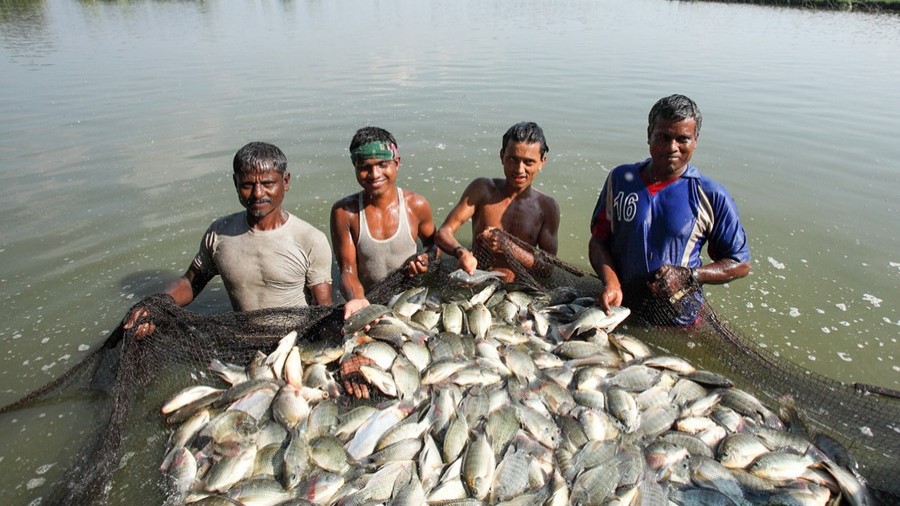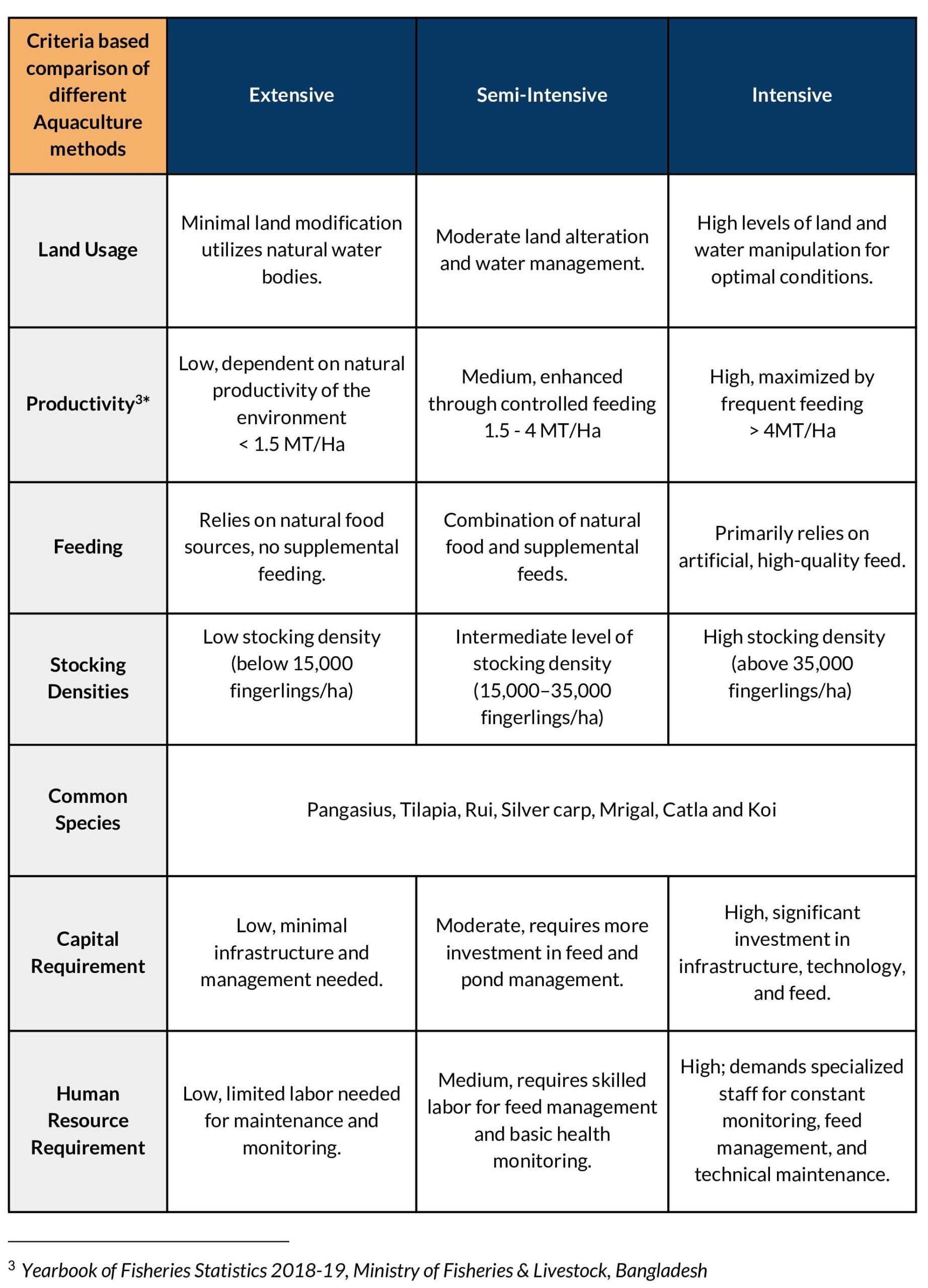GET IN TOUCH
- Please wait...

Aquaculture is defined by the UN’s Food and Agriculture Organization (FAO) as the farming of aquatic organisms including fish, molluscs, crustaceans, and aquatic plants. Farming implies some sort of intervention in the rearing process to enhance production, such as regular stocking, feeding, protection from predators, etc. Farming also implies individual or corporate ownership of the stock being cultivated, the planning, development, and operation of aquaculture systems, sites, facilities, practices, production, and transport.
Aquaculture, which has existed for thousands of years, began significantly contributing to global food supplies and rural economies approximately three decades ago. In 1974, aquaculture accounted for only 7% of fish for human consumption, but by 1994, this share rose to 26%, and by 2020, it reached 46%.
Over the past 50 years, per capita consumption of aquatic foods has more than doubled, averaging around 20.2 kg globally in 2020. Consequently, global production soared to 214 million tonnes by 2020, with aquatic foods supplying approximately 17% of the world’s animal protein intake, exceeding 50% in some Asian and African countries.
In recent times, there has been a notable shift in aquaculture towards more semi-intensive and intensive methods of farming, marking a significant change in the industry’s approach. This shift is driven by the goals of achieving greater profitability and productivity.
The Food and Agriculture Organization (FAO) notes that this change is necessitated by the growing global demand for seafood, coupled with the need for better use of resources. The transition from Extensive to Semi-intensive farming involves controlled pond environments, while intensive farming uses sophisticated technologies like recirculating aquaculture systems (RAS).
Intensive farming techniques like RAS let producers maximize space utilization by maintaining a closed-circuit, high-density system. The recirculating system removes or converts produced waste products; solid waste, ammonium, and CO2 into non-toxic products. The purified water is subsequently saturated with oxygen and returned to the fish tanks. By recirculating the culture water, the water and energy requirements are limited to an absolute minimum.
Countries leading this shift, such as China, Vietnam, and Thailand, have adopted these methods for their potential to produce higher yields and economic benefits. The trend towards more intensive forms of aquaculture is partly motivated by the desire to improve food security and take advantage of the efficiencies that come with increased production.

Semi-Intensive Aquaculture: Semi-intensive farming refers to the practice of utilizing the natural environment of the farm to provide supplemental feed inputs to the aquatic species. Although some artificial feed is used, the primary food source is natural feed. Characterized by its high levels of entrepreneurship initiative and higher productivity and efficiency than traditional farming, semi-intensive farming practice has the potential to spread over wide areas and contribute substantially to local fish production.

Production systems usually require some investment in water management and environmental control, albeit much less than large-scale intensive commercial farming. The volume produced exceeds the natural carrying capacity of the water body and can be made successful with a small amount of supplementary artificial feeding and moderate management.
The most common type of semi-intensive system for finfish are ponds, normally made of earth and sometimes lined with clay, fed by a stream or other water source. Harvesting is usually organized and the value chain is longer than extensive aquaculture, with fish normally being sold in local villages and towns, depending on the market linkage. Attached below is an illustration of a typical semi-intensive fish pond.

In the fiscal year 2021-22, Bangladesh’s fisheries sector maintained its substantial contribution to the economy, achieving an aquaculture production of 4.7 million metric tons. The country ranks 3rd globally in inland water capture, cage culture, and pen culture production.
Important species such as carp, pangasius, and tilapia play a central role in freshwater fish production. Shrimp farming also thrives, yielding 261 thousand metric tons in 2021-22.
Bangladesh earned USD 471 million in foreign currency during the FY 2022-23, from the exports of aquatic products, (primarily frozen & live fish) albeit undershooting the target set for the period by USD 212 million and constituting <1% of the total export basket.
Bangladesh has over 125 aqua processing facilities, primarily located in port cities like Khulna and Chittagong. Although fish processing levels are relatively modest, there is an expected uptick in retail sales of processed fish, mirroring the growth of disposable income within the country’s population.
As consumer purchasing power increases, there’s a logical and noticeable shift towards higher-value species and processed fish products, particularly in urban areas. However, the shifting demographic and increasing urbanization, while creating demand, are leading to the loss of land for aquaculture.
Under the circumstances, large-scale extensive farming makes little sense, as it requires more land and offers a low yield per hectare. Hence, Bangladesh must adopt low land requirement-based aquaculture methods, namely semi-intensive or intensive farming. The nation depends on aquaculture as its primary source of protein, mainly due to its availability at rural markets and lower cost per kg compared to other sources of meat.
One of the major hindrances to this adoption is the access to finance required for setting up the system. With intensive farming, the problem is exacerbated, as it requires a higher amount of capital to finance the technologically advanced, automated artificial feeding-based aquaculture system.
Lack of supporting technology infrastructure, know-how, and low awareness among farmers might prove to be major bottlenecks. Although there might be a business case for large-scale, commercial, private sector players, for individuals or small local business ventures, there’s limited scope for mass adoption of the intensive production process.
Under this context, the widespread adoption of semi-intensive farming, which requires little capital investment, albeit higher than extensive farming, can be considered a viable way forward, due to several reasons outlined below:
Navigating the shift towards semi-intensive aquaculture practices, however, presents a series of systemic challenges for Bangladesh, primarily due to the absence of key elements essential for this transition. These challenges not only impede the progression towards more efficient and sustainable aquaculture methods but also affect the country’s ability to meet the rising demand for fish.
The following components are necessary to create a conducive environment for the widespread adoption of more technically proficient and productive farming practices.
Access to affordable credit and financing instruments is essential for small-scale farmers to invest in semi-intensive aquaculture infrastructure, such as ponds, feed, and equipment. Lack of access to credit or high interest rates can impede farmers’ ability to make necessary investments, slowing down the transition process.
Farmers lacking access to formal finance at the rural level often resort to taking high-interest-rate loans from MFIs and local loan sharks. Amidst the current macroeconomic conditions and high-interest rate regimes, specialized credit products should be available to support farmers at the grassroots level.
Active involvement of the private sector, farmers, and producer groups is crucial for the successful adoption of semi-intensive aquaculture practices. Contract farming arrangements between farmers and formal processors, where financing and profit are mutually shared along with the means of production, are broadly perceived as a key tool for improving social welfare, enhancing global food security, improving technology and food quality, and increasing employment and productivity.
The tool helps farmers overcome production constraints of finance and insurance, poor access to goods inputs, and the shortage of technical and managerial capacity. Private sector participation brings in investment, technology, and market linkages, while their engagement with farmers and producer groups ensures adoption at the grassroots level. Without their collaboration, there’s a gap in the transfer of knowledge, resources, and support needed for the transition.
A critical mass of know-how, both in the public and private sectors, is essential for driving innovation, providing technical assistance, and overcoming challenges in semi-intensive aquaculture practices. This includes expertise in breeding, disease management, feed formulation, and market access.
Without sufficient know-how at the national level, there’s a lack of capacity to address technical and operational issues, limiting the scalability and sustainability of aquaculture practices. Regulatory authorities and relevant government institutions have a crucial role to play in developing this awareness, especially at the rural level.
The National Aquaculture Development Strategy and Action Plan of Bangladesh 2013–2020 constituted 16 outputs under four objectives. Notably, Output 1.2 was the semi-intensification of existing extensive farms and intensification of suitable semi-intensive farms. Following the expiration of its timeline, an updated strategic aquaculture development strategy could provide a roadmap for the sustainable development of the aquaculture sector, incorporating contemporary technological developments.
The plan should outline goals, objectives, and strategies to guide the industry’s growth while addressing environmental, social, and economic concerns. Without such a framework, there exists a high chance of a lack of direction and coordination among stakeholders, hindering efforts to transition to semi-intensive aquaculture practices efficiently.
Addressing these gaps requires concerted efforts from policymakers, industry stakeholders, financial institutions, and development agencies to create an enabling environment for the transition to semi-intensive aquaculture practices in Bangladesh. This may involve the formulation of strategic policies, promoting private sector participation, improving access to finance and technical know-how of farmers, and investing in capacity building and knowledge transfer initiatives.
In order to help address some of these crucial gaps, FoodTechBangladesh, a four-year-long (September 2022–August 2026) aid-to-trade programme co-financed by the Kingdom of the Netherlands and coordinated by Larive International B.V., and LightCastle Partners Ltd. is designed to support the development of the aquaculture sector in Bangladesh.
Through a partnership of private sector companies from Bangladesh and the Netherlands, its partners jointly cooperate to further bolster the trade relationship of the countries in the field of aquaculture and strengthen the global commercial positioning of the aquaculture sector in Bangladesh.
More specifically, the partnership aims to contribute to improving the technical performance of fish breeders and farmers in Bangladesh by demonstrating best practices and transferring know-how (e.g. by providing training programs).
As part of this programme, 3 Centers of Excellence (demonstration farms) will be established to train (on-site & online) at least 1,600 fish and shrimp breeders and farmers on innovative and sustainable breeding and cultivation methods. The species being considered include: Pabda (Catfish), Tilapia, Rohu (Carp), Barramundi, and Rosenbergii (giant freshwater prawn).
The program is also engaged with the Department of Fisheries (DoF) in Bangladesh to disseminate the training through their extensive field-level presence across the country. Leveraging the technical expertise of the Dutch aquaculture sector, FoodTechBangladesh aims to demonstrate successful cases for the usage of modern farming technologies, which are also scalable across the masses.
The interventions of the programme are expected to increase the average production of the aquaculture breeders and farms by 10–15 times through the adoption of advanced equipment, better hatchery and farm management practices, and improved health and safety protocols.
The program acknowledges the need for Bangladesh to refine its farming practices and the value that lies therein. Recognizing the critical role of sustainable and efficient practices in meeting the growing demand for fish, this initiative is dedicated to implementing advanced techniques and technologies.
By prioritizing innovation and sustainability, the program aims to equip Bangladeshi farmers with the tools necessary for a transformative impact on the aquaculture industry, ensuring a future where the sector not only thrives but also contributes significantly to the nation’s food security and economic prosperity.
Our experts can help you solve your unique challenges
Stay up-to-date with our Thought Leadership and Insights